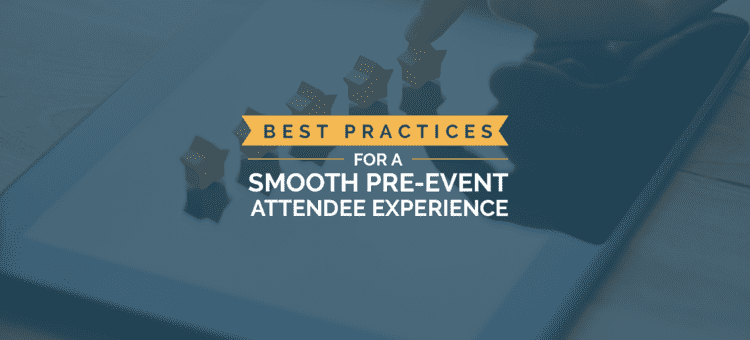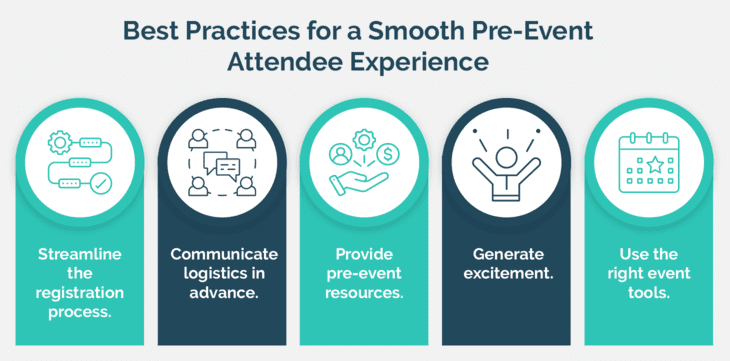
As a nonprofit event organizer, you’re likely focused on making the day of your event as perfect as possible. From securing the venue to recruiting sponsors, you spend countless hours planning and organizing the details that will launch your event to success.
However, attendees’ event experience doesn’t begin on event day. It starts way before that with discovering your event, registering online, and getting ready to attend.
If you don’t properly prepare and engage attendees before your event, how do you expect them to show up and remain engaged during your event? Providing a smooth, immersive pre-event attendee experience allows guests to arrive at your event ready and eager to participate. We’ll provide five best practices so you can capture attendees’ attention before your event even begins.
1. Streamline the registration process.
One of the first touchpoints you have with attendees is registration. When you run an efficient event registration process, you allow attendees to easily sign up for your event and make a positive first impression on them.
The best way to streamline registration is with dedicated event registration software. This type of tool facilitates online registration so your team can spend more time on other areas of event management.
When you use event registration software, you’ll introduce the following benefits into the pre-event experience:
- Improved attendee experience. The top benefit of event registration software is that attendees can quickly and easily sign up for your event. They can also gain access to important event information ahead of time so they begin to plan their event experience.
- Increased event sign-ups. Since this type of software makes it so easy for attendees to sign up, you’ll see higher registration numbers and therefore higher attendance rates. You may incentivize early registration even further by offering discounts through your registration platform.
- Access to more attendee data. When attendees register through your software, you’ll gain access to demographic and contact information that you can store in your constituent relationship management system (CRM) for future reference. You can also collect information that helps you plan for your event accordingly, such as registrant type and status and the number of registrants per session.
To find the best event registration platform for your nonprofit, read reviews on sites like G2 or GetApp to gauge other organizations’ experiences with different software options. It’s also best to choose a tool with various customization options such as editable forms and branded elements to tailor the registration experience to your organization.
2. Communicate logistics in advance.
After attendees register for your event, send them an online invitation that welcomes them and provides important event information. When you communicate event logistics well in advance, you allow attendees to prepare and reduce event day stress.
Give attendees access to the following information:
- Event schedule or lineup
- Location
- Transportation options
- Parking instructions
- Additional preparations or prerequisites
Not only will distributing this information early help attendees get ready for your event, but it will also save staff members time by answering frequently asked questions (FAQs) in advance.
3. Provide pre-event resources.
As the event gets closer, provide pre-event resources that help attendees get the most out of the event experience. As opposed to event logistics, these materials should go more in-depth about the content of the event and what attendees can expect once they check in.
Your pre-event resources may include:
- Keynote speaker bios. Introduce attendees to your keynote speakers ahead of time so they can learn more about their background and prepare any questions they may have.
Session topics. Give attendees a taste of what they can expect to learn or hear more about during your event. - Event-specific resources. Depending on your event type, you may have event-specific resources to distribute. For example, if you’re hosting an auction, you may send attendees your auction catalog so they can peruse the items ahead of time and plan for what they want to bid on.
- Networking opportunities. Let attendees know about any opportunities they’ll have to mingle with others in the industry, such as a dedicated time for coffee chats or a room at the venue open for attendees to meet with each other.
- Sponsors. Your event sponsors make your event a reality. Promote them to your attendees ahead of time, and get guests excited about any branded activities or special opportunities your sponsors will provide.
In addition to these materials, you may also send attendees a pre-event survey. This survey can help you understand attendee expectations and tailor the event to their needs and preferences.
4. Generate excitement.
While it’s important to keep attendees informed leading up to your event, you’ll also want to get them excited about the experience. NXUnite by Nexus Marketing recommends using a variety of platforms to market your event, especially social media so you can encourage attendees to interact with your content and each other.
Generate excitement for your event using the following techniques:
- Sneak peeks. Give attendees a behind-the-scenes look at your event with teasers, photos of the venue, and speaker testimonials.
- Countdowns. Add a countdown to the start of your event on your website and on social media to build anticipation amongst attendees.
- Contests. Introducing an element of gamification into your pre-event experience can help engage attendees before they even step in the door. For instance, you could have attendees repost a photo from your nonprofit’s social media accounts as an entry to win event memorabilia or access to an exclusive event session.
When teasing your event, try to strike a balance between giving attendees a taste of what they can expect and leaving some elements as a surprise for the event day. For example, you may show attendees what the venue looks like but wait to let them see all of the decorations and final touches when they arrive.
5. Use the right event tools.
According to EventMobi’s conference app guide, 78% of organizations that use event apps see a positive return on investment (ROI) from the software. With a comprehensive event app, you can:
- Keep everything in one place for attendees
- Facilitate communication before, during, and after the event
- Help attendees familiarize themselves with your event technology before the event day
You may also use a more general event management software to build an event website, design badges, and run email marketing campaigns that promote your event and provide attendees with updates as the day gets closer. Look for a platform that allows you to segment your communications by registration status, payment status, or demographics so you can personalize your pre-event messaging.
One of the building blocks for a successful event is pre-event attendee engagement. When you communicate with attendees and share information before your event, you’ll set the tone for what they can expect and get them excited about attending. As a result, you’ll have higher attendance and engagement on the event day, allowing you to meet your event goals and promote your mission to a wider audience.